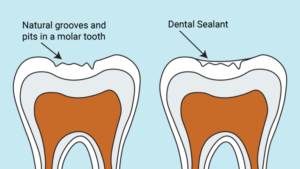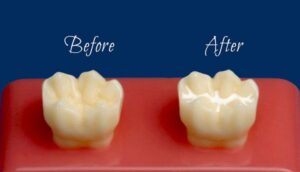
Oral Health Promotion Goals
1. Increase access to school-based Oral Health Disease Prevention Programs for targeted, dentally at-risk children in all counties in the DHD#10 jurisdiction.
2. Reduce dental disease for children that are provided dental services.
3. Provide all counties in the DHD#10 jurisdiction elementary schools and Head Start Centers with oral health education and resources.
4. Referral access to care for at-risk adults in all counties in the DHD#10 jurisdiction.

School-based Sealant Program
SEAL! Michigan is a school-based sealant program targeting first, second, sixth, and seventh grade children. All services are provided within qualifying schools using portable dental equipment. This prevention focused program offers:
- classroom oral hygiene education
- screenings by a registered dental hygienist who will determine if the student has teeth that require dental sealants
- sealant placement
- follow-up checks to determine the retention of dental sealants
- referrals for students that require further dental services
- A dental sealant is a white liquid that is painted on the grooves of the back teeth (molars) and hardens to prevent or seal out decay. Sealants have been proven to reduce tooth decay by more than 70 percent, resulting in lower dental treatment costs and healthier children.


Dental sealants are thin coatings that when painted on the chewing surfaces of the back teeth (molars) can prevent cavities for many years. School-age children (ages 6-11) without sealants have almost 3 times more 1st molar cavities than those with sealants. Although the overall number of children with sealants has increased over time, low-income children are 20% less likely to have them and 2 times more likely to have untreated cavities than higher-income children. Untreated cavities can cause pain, infection, and problems eating, speaking, and learning. States can help millions more children prevent cavities by starting or expanding programs that offer dental sealants in schools.
Kindergarten Oral Health Assessment (KOHA)
- MDHHS KOHA Assessment Form
- Michigan Kindergarten Oral Health Assessment Program
- Michigan State Oral Health PLAN 2025
- Michigan.gov Oral Health Website
- Michigan passed a law to ensure kids enrolling into their first year of school have an oral health assessment prior to starting school as part of school readiness activities for kindergarten entry. Check with your child’s school for details, as each school notifies parents and distributes the required form, which includes information about the law, consistent with school district polices. You may also talk to your current dental provider to assist with completing this assessment. To obtain more information and FAQ’s, we also encourage you to review our Parents Letter.
- Although fully preventable with access to a dentist and education, dental cavities remain the #1 chronic childhood disease and is responsible for 51 million missed school hours, nationally, each year. Children with poor oral health are 3 times more likely to miss school due to pain and infection linked to dental cavities. Tooth decay is a significant public health problem in Michigan. More than 1 in 3 Michigan Head Start children (35%) has already experienced tooth decay, almost 1 out of 4 Head Start children (22%) in Michigan have untreated tooth decay (MDHHS, 2018). Students in Michigan need healthy teeth and to be pain free to ensure they can achieve their highest individual learning potential while in school.
What can you do to help?
- Notify Parents
- Provide Access
- Raise Awareness
- Compile Data
To help with these requirements and to gain more information, please review our School Dental Flyer.
- Michigan’s new required Kindergarten Oral Health Assessment (KOHA), or evaluation, can be met in many ways. It can be a complete examination and treatment plan performed by a dentist, or it can be a more basic oral health evaluation, such as a assessment, which can be performed by a dentist, hygienist or an extended function registered dental assistant with supervision.
- The state-required assessment form (MMDHD Health Appraisal form) is simply a tool to collect data about children’s health to ensure they are ready to learn at the time of starting school. After you complete the form, you provide the form and the findings back to the parent or caregiver and they provide it to the school.
To learn more and receive the required forms, please review our Dental Practice Flyer.
Oral Health Education
- Oral health educational presentations have been developed to educate school children about the importance of proper oral health habits and provide programming that will motivate them to practice these habits throughout their lifetime. An interactive presentation is utilized to make it fun for the students to learn. Oral health education is important to help students be aware that with proper homecare and routine care from a dental professional their teeth can last a lifetime.
- Oral health educational presentations for parents, adults and seniors have been developed to educate about the importance of proper oral home care, routine preventive care from a dental professional and having a dental home.

Children’s Fluoride Varnish Program
Tooth decay is the most common (five times more prevalent than asthma) and preventable chronic disease of childhood. Children as young as 12-18 months can experience early childhood caries (tooth decay). The Fluoride Varnish Program services families and WIC children ages 0-6 in all counties in the DHD#10 jurisdiction. The program provides dental screenings and fluoride varnish to these children.
Fluoride varnish is a protective coating that is painted on teeth to help prevent new cavities and to help stop cavities that have already started. The “paint on” fluoride varnish is sticky, so it adheres to the teeth easily and makes the outer layer (enamel) of the teeth more resistant to decay. The American Dental Association (ADA) considers fluoride varnish to be a safe and effective as part of a caries prevention program.
- Fluoride Varnish: What you need to know
- Varnish! Michigan Free Fluoride Program for Medical Providers
- Drool to School
- Community Water Fluoridation
- How Fluoridation Works
- Varnish Michigan Fluoride Program
- Varnish Michigan Program

Why is Fluoride Important?
Fluoride varnishes are used to protect the teeth and to help prevent tooth decay. These fluoride treatments can be done two or four times per year. How often you get the treatments for your child is directly related to how likely it would be for your child to get a cavity.
The tincture which is known as the fluoride varnish is simply painted on the tops and the sides of each tooth with a little brush. At first, the substance may feel a bit sticky but as soon as it comes into contact with saliva it hardens. While your child might be able to feel the hardened varnish, they are not able to lick the varnish off of their teeth.
No pain is involved during the application process. Brushing the varnish onto the teeth only takes a couple of minutes while you sit knee-to-knee with the person who is applying the varnish.

MCDC
- MCDC and Oral Health Care
- MCDC Dental Clinics
For more information about our Dental Health Clinics, please contact:
Elizabeth Johnson, RDH, BS
Oral Health Coordinator, DHD#10
(231) 674-5218

